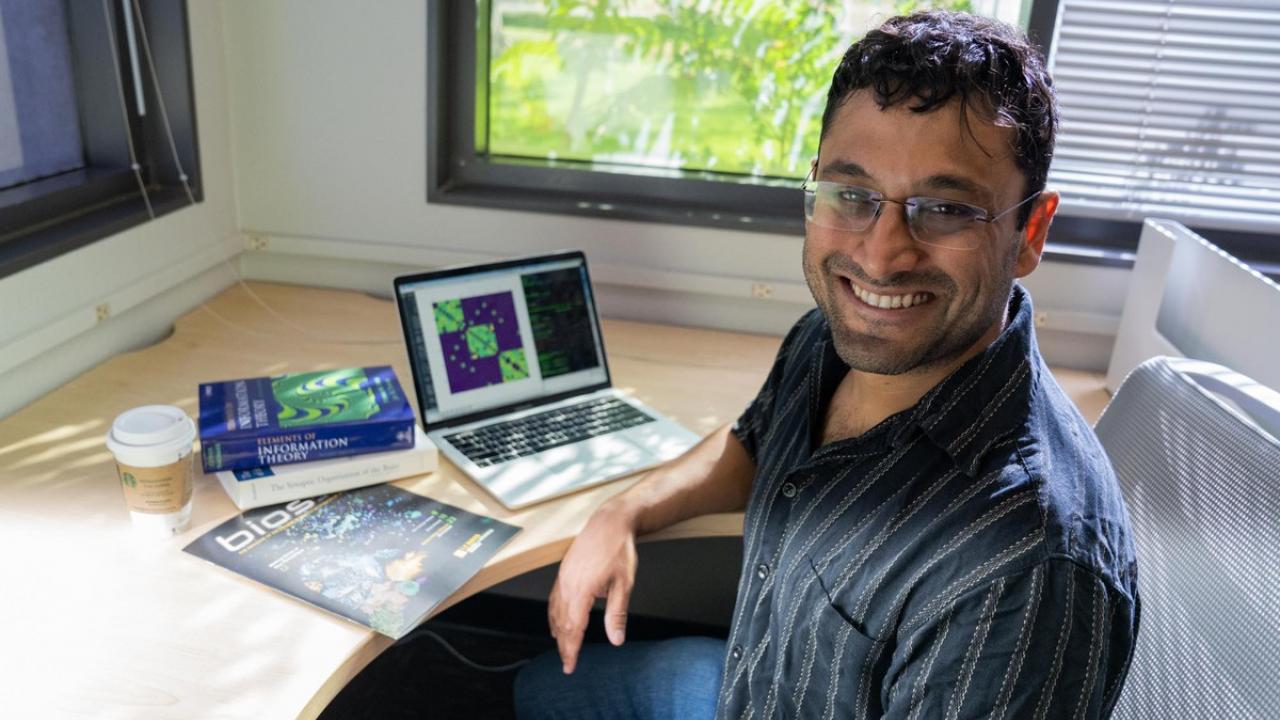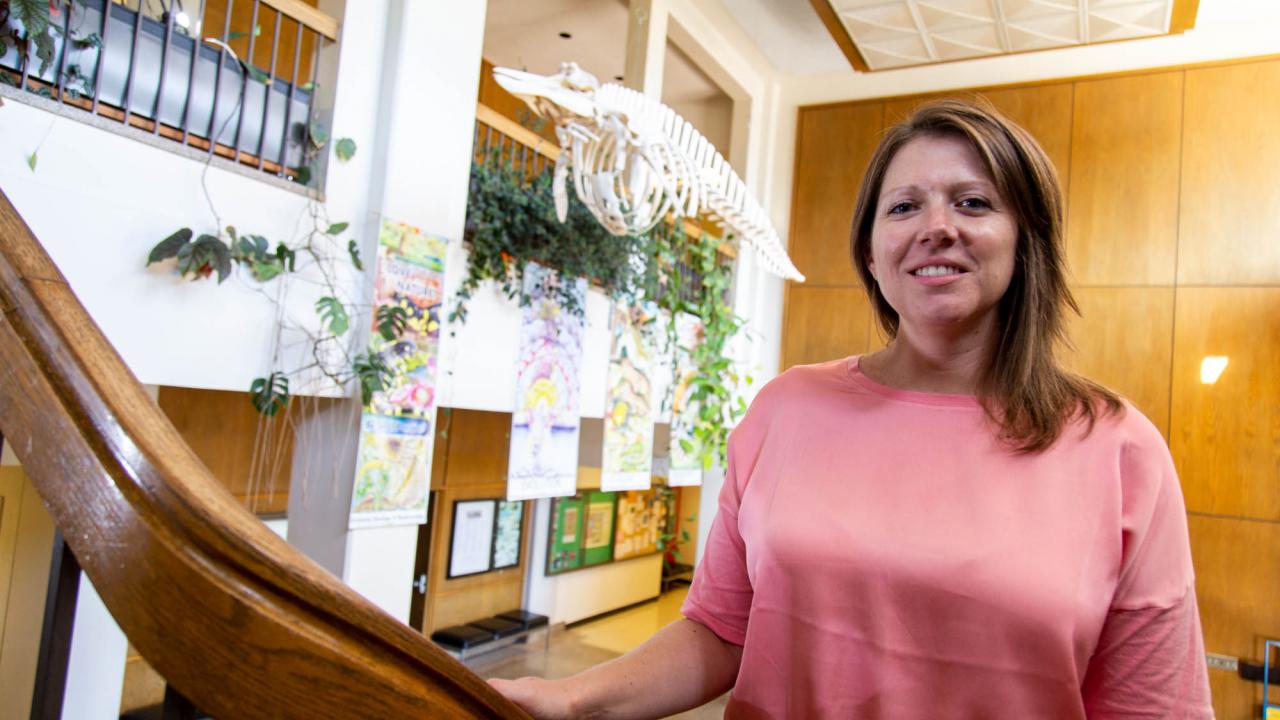
Perception Inception: Exploring How the Brain Makes Up the World with New Faculty Rishidev Chaudhuri
Quick Summary
- Rishidev Chaudhuri is a new faculty member who holds appointments in the Department of Neurobiology, Physiology and Behavior, the Department of Mathematics and the Center for Neuroscience
- His research spans the field of neuroscience, from exploring theoretical principles of neural computation to analyzing large neural datasets, and other topics outside and in between
- He takes techniques from physics and mathematics and applies them to neuroscience
The world is made of matter, but between those particles are empty spaces, which paradoxically account for the majority of our perceived, concrete universe.
“This table feels hard,” said Assistant Professor Rishidev Chaudhuri, who sat in his office at the UC Davis Center for Neuroscience. “That’s something that emerges at the collective population level.”
How individual particles come together to spontaneously create new structures is a question pondered by many physicists. The concept underlying that question—collective behavior—also intrigues neuroscientists.
Your brain is a collection of neurons. In isolation, a single neuron is practically useless, but when working in tandem with innumerable other neurons, the network quite literally creates the world, transforming the photons your eyes perceive into a seamless visual experience.
“How does the brain create the world from all of those pieces?” wondered Chaudhuri, who holds joint appointments in the Department of Neurobiology, Physiology and Behavior and the Department of Mathematics.
Chaudhuri studies processing strategies in the brain using principles from mathematics and physics. His research spans the field of neuroscience, from exploring theoretical principles of neural computation to analyzing large neural datasets, and other topics outside and in between.
“The fact that the brain’s making the world, the world’s making the brain, that we’re in this constant, dynamical flux is super fascinating,” said Chaudhuri.

A physicist first
Chaudhuri’s first academic love was physics. Questions about space and time suffused the academic field and swirled around Chaudhuri’s mind during his formative college years. Fascinated by complex systems, he soon began exploring how patterns and principles applied in physics could be applied to society, economics and even biology.
“It seemed like all the interesting questions were in biology,” said Chaudhuri, who noted he was drawn to neuroscience because the field represented one of the frontiers of knowledge.
“What algorithms is the brain running?” he said. “What information processing strategies? What kind of data structures? A lot of the questions you might ask in terms of a computer, except you’ve got this big, distributed, messy biological system with millions of neurons.”
After completing his undergraduate degree at Amherst College, Chaudhuri moved back to the Bangalore area in southern India, where he grew up. He wanted to pursue graduate studies but thought a break from school would help him determine his next academic steps.
“I wanted to be an academic since I was six,” said Chaudhuri. “I wanted to take some space and just think about things.”

He spent time hiking the Himalayas and working as a journalist and silkworm farmer. After being accepted into an applied mathematics graduate program at Yale University, he returned to the United States.
Yet biology was still in Chaudhuri’s sights. His thesis work concerned the neocortex, the part of the mammalian brain responsible for sensory perception, language and consciousness, among other higher functions. Using mathematical modeling, Chaudhuri tried to create a bridge between the different anatomical features of the neocortex and its various functions.
“As you move from the back of the brain to the front of the brain, neurons change their shapes; they change the number of connections; they change their receptor types,” he said. “But there seem to be almost smooth gradients so they change gradually and that kind of anatomical variation helps create the functional variations.”
After graduation, Chaudhuri rotated through a handful of postdoctoral positions. He was a Google Research Fellow at UC Berkeley’s Simons Institute for the Theory of Computing, a postdoctoral associate at New York University’s Center for Neural Science and a postdoctoral fellow at The University of Texas at Austin’s Center for Learning and Memory. In April 2019, he joined the UC Davis faculty.

Attack of the Clones: Investigating the Non-Genetic Origins of Behavior with New Faculty Kate Laskowksi
Assistant Professor Kate Laskowski is a new faculty member who holds an appointment with the Department of Evolution and Ecology.
Seeking the “Rosetta Stone” of math-physics-biology
Chaudhuri is in the midst of setting up his lab at UC Davis. Unlike a wet lab, his space isn’t outfitted with workbenches and chemicals. Instead, it’s equipped with computers, which Chaudhuri uses to mathematically model neurological phenomena. Working with his Center for Neuroscience colleagues, Chaudhuri performs research that crosses disciplinary boundaries. Active research threads include spatial mapping in the brain, memory retrieval and the effect of sleep on the brain.
“You’re trying to build a theory and the right language for that is often mathematical,” said Chaudhuri of his work. “Can I describe the response of this neuron to some input in terms of an equation? Once I’ve done that, does the equation tell me something about what another neuron is doing or how these neurons are talking to each other or what the system is doing?”

In a study recently published in Nature Neuroscience, Chaudhuri and his collaborators used neural activity data recorded from the brains of mice to learn about how the brain locates and identifies the direction of the body in space and how waking experiences are reinforced during sleep. In another study, Chaudhuri and other colleagues proposed theories about the brain’s mechanisms for retrieving memories.
“You need to remember a tremendous number of things; why don’t those things overwrite each other?” he said. “How should they be stored so as to keep them separate?”
To create their models, the team was inspired by error-correcting codes used in internet and telephone communications. “There’s this beautiful mathematical theory around error-correction and it turns out that you can map some of that theory to memory,” said Chaudhuri.
“Error-correcting codes,” he continued, “add redundancy to a signal, so that it can be recovered even if some pieces are missing or corrupted. A simple way to add redundancy is just to repeat the message (or memory) multiple times, but this strategy is inefficient. It turns out there are much cleverer strategies, that are both redundant and highly efficient, and we showed that the brain could in principle use some of these.”
Chaudhuri is now launching new projects. While creating a new research world for himself at UC Davis, he's looking for students to join his research efforts.
For inspiration, Chaudhuri often looks to the discipline of philosophy. The musings of Immanuel Kant and William James, among others, provide fodder for his neuroscience research.
“I see philosophy as a way of generating ideas as opposed to a way of telling you what’s true,” said Chaudhuri. “The philosophers I like are the ones who push me to think about a problem in a new way.”
“There’s a lot of scope for that in thinking about the brain.”

